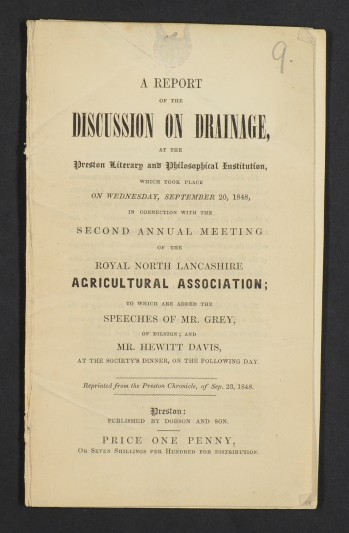The Museum of English Rural Life at the University of Reading purchase of twenty-two rare agricultural pamphlets from the mid-19th century, which relate to the agricultural innovations and economics of the period, enhancing its existing collection strengths in British agricultural history. The collection includes rare works on early applications of agricultural chemistry, studies of production and demand, and farmers’ reports on the use of new agricultural equipment. They provide a unique insight into the economic and technological developments in British agriculture in the mid-19th century, a pivotal period that marked the final stages of the British Agricultural Revolution.
Key innovations of this period that are represented in these pamphlets include the improvement of agricultural drainage systems and the development of new fertilisers beside manure, such as guano (seabird excrements), sodium nitrates and potash. Another pamphlet promotes George Dollond’s ‘atmospheric recorder’, a type of weather station that records variations in air pressure, temperature and humidity, for which he was awarded the council medal at the Great Exhibition of 1851. Not all innovations were as successful. One pamphlet deals with the promotion of the alpaca as a profitable alternative to other breeding stock in England, claiming that the alpaca is ‘as fat as any sheep I ever saw’ and that the animals ‘never ramble from their hill pasture’. In case alpacas are not of interest, the advertisers add that they also sell ‘turtle alive, or ready cooked and securely packed in jars’…
Most of the pamphlets were written by enthusiastic farmers or promoters of new farming methods and agricultural equipment. It was through cheap, often locally printed pamphlets such as these that farmers could keep on top of these developments. Therefore, pamphlets from this period are an important historical source for studying the farmers’ perspective on agricultural innovations.
These pamphlets were part of the collection of Sir Walter Gilbey (1831–1914), who was the president of the Royal Agricultural Society of England in the late nineteenth century. He donated his collection to the Society in 1896, where they remained until they were sold along with the rest of the RASE collections in 2014. They will now join the rest of our extensive collections. The library and archives at the Museum of English Rural Life are recognised as one of the most important collections in the country for the study of the history of British agriculture, the countryside and rural society. All items can be consulted in our reading room.
